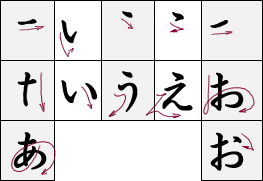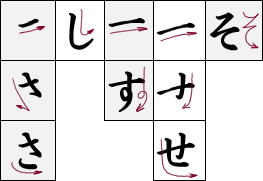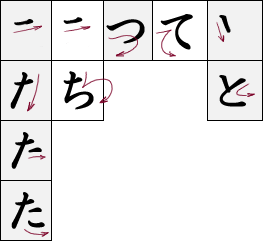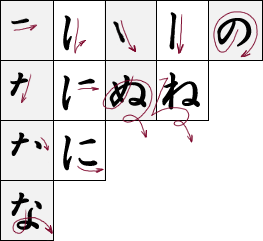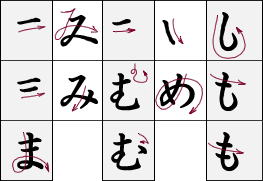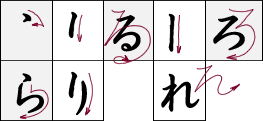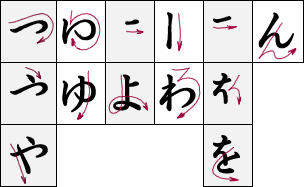Lesson 0: hiragana
What does hiragana look like?
The hiragana syllabary consists of 46 characters, as shown in the below table, which in Japanese order is read vertically from top to bottom, and starts at the right, working to the left.
ん わ ら や ま は な た さ か あ り み ひ に ち し き い る ゆ む ふ ぬ つ す く う れ め へ ね て せ け え を ろ よ も ほ の と そ こ お
These characters are approximated by western (in fact, English in this case) phonetics, as is shown in the following table. However, note that for some of these there is a [...] instead of a consonant - this indicates that there is something special going on and I need to give you more explanation before I can trust you get the sound right ^^
n(m) wa ...a ya ma ha na ta sa ka a ...i mi ...i ni chi shi ki i ...u yu mu ...u nu tsu su ku u ...e me he ne te se ke e wo ...o yo mo ho no to so ko o
So what's up with those [...] markers? What should they represent? Before answering this, we need to cover the vowel sounds, so we can look at those odd consonant entries. Most Japanese syllables can be approximated in western languages by combining a consonant sound with a vowel sound, using the following five vowels:
- あ is pronounced like the 'a' in 'father', but with a more open mouth, similar to the 'aa' in "aah! what are you doing" but naturally, shorter in duration.
- い is similar to the 'ea' in 'eagle', but slightly shorter.
- う sadly has no real English equivalent, but it is similar to the Italian 'u' in words like 'multi' and 'tutti', not entirely unsimilar to the scottish "u" (bless accents).
- え is similar to the 'e' in 'help'.
- お is similar to the 'o' in 'hold'.
With the vowels down, let's cover those seven odd syllables we noted earlier. Textbooks often have the nasty (but understandable) tendency to want to label the ninth (remember, counted from the right) columnn as having an "r" consonant, but this is not correct from both the auditive and biomotoric perspective... the consonant used is one that can cover the full range of alveolar consonants, with no regards to the shape of the tongue. That probably means nothing to you, so do the following: say r-r-r-r-r-r-r-l-l-l-l-l-l-d-d-d-d-d-d in one go (without vowel sounds, so no "ar", "el" or "dee") and notice that the tip of your tongue is hitting the same part of your mouth, behind the teeth (the alveolar region), and really the only thing that changes is the shape of your tongue. To a Japanese, these all sound the same, rather than three different sounds. How to romanise it then?? Well, why would we? We just use the Japanese symbols instead, and all is well (if you can't use Japanese though, the accepted romanisation is "r", but remember this does not reflect the true sound, because some Japanese people might use what sounds like an "l", and everyone in Japan would know they were saying something from the 9th column of the syllable table)
The other two "missing consonants" are less problematic (or at least so I believe). The consonant for ひ is essentially an "h" with a little bit of "g" mixed through. The last one, ふ is the real pickle: it sounds like nothing we have in most western languages (I've been informed there is a consonant similar to it in Danish, but the odds that you know Danish are fairly low). Instead of being a consonant of sorts, this sound is made by forcing air up using your diaphragm, and vocalising a Japanese う after it. Textbooks have the nasty tendency to explain this as "an 'f' sound", but that is most definitely not what it is at all. An "f" is formed with the lips relaxed, the lower lip touching the upper teeth, and air escaping from this position. A ふ has the lips in a position as if you were blowing out a candle, and air being able to flow out entirely unobstructed. This is a wildly different formation.
Learning how to pronounce the ふ is actually fairly easy as long as you remember you're not trying to do an "f": Blow out a match (or act out blowing a match). You will only blow midly hard, because a match doesn't need much wind. Now put down the match and repeat this, with your lips relaxed instead of pouted. That's all there is to it. That's the starting sound for the ふ. I know it doesn't sound like a consonant, but that's because this isn't western language so it doesn't have to be a consonant. Strictly speaking "consonants" do not exist in Japanese, so try to let go of the idea that Japanese syllables are consonant+vowel combinations. Most can be described as such, but some cannot.
That covers the basic 'unvoiced' characters, but just like western language has divided voiced/unvoiced into their own sections in the pronunciation tables, so have the Japanese. They've done it more elegantly: where we use different letters, the Japanese use the same character but with a voicing sign ゛ to their upper right:
|
ん |
わ |
ら |
や |
ま |
ば |
な |
だ |
ざ |
が |
あ |
|
り |
み |
び |
に |
じ |
じ |
ぎ |
い |
|||
|
る |
ゆ |
む |
ぶ |
ぬ |
ず |
ず |
ぐ |
う |
||
|
れ |
め |
べ |
ね |
で |
ぜ |
げ |
え |
|||
|
を |
ろ |
よ |
も |
ぼ |
の |
ど |
ぞ |
ご |
お |
Which can be approximated with the following western character combinations:
|
n |
wa |
ra |
ya |
ma |
ba |
na |
da |
za |
ga |
a |
|
ri |
mi |
bi |
ni |
ji |
ji |
gi |
i |
|||
|
ru |
yu |
mu |
bu |
nu |
zu |
zu |
gu |
u |
||
|
re |
me |
be |
ne |
de |
ze |
ge |
e |
|||
|
wo |
ro |
yo |
mo |
bo |
no |
do |
zo |
go |
o |
Notice the two exceptions from what you would expect, ち becoming じ and つ becomeing ず. These used to be the entirely predictable ち->ぢ and つ->づ but in modern Japanese no one can tell the difference between a ぢ and a じ or between a づ and a ず anymore, so the ministry of education decided to scratch ぢ and づ from the syllabary tables. However, these character with ゛ still occur as 'pronunciation writing' over kanji when voicing occurs in compound kanji words. So they don't exist, but they do... I know that's not the most consistent of things, but sometimes (well.. sometimes?) even governments don't think plans through 100% =)
Finally the は/ば series also has a third 'alteration' consisting of an ゜instead of ゛ in the upper right:
|
ん |
わ |
ら |
や |
ま |
ぱ |
な |
た |
さ |
か |
あ |
|
り |
み |
ぴ |
に |
ち |
し |
き |
い |
|||
|
る |
ゆ |
む |
ぷ |
ぬ |
つ |
す |
く |
う |
||
|
れ |
め |
ぺ |
ね |
て |
せ |
け |
え |
|||
|
を |
ろ |
よ |
も |
ぽ |
の |
と |
そ |
こ |
お |
Which has as corresponding western sounds:
|
n |
wa |
ra |
ya |
ma |
pa |
na |
ta |
sa |
ka |
a |
|
ri |
mi |
pi |
ni |
chi |
shi |
ki |
i |
|||
|
ru |
yu |
mu |
pu |
nu |
tsu |
su |
ku |
u |
||
|
re |
me |
pe |
ne |
te |
se |
ke |
e |
|||
|
wo |
ro |
yo |
mo |
po |
no |
to |
so |
ko |
o |
Notes on pronunciation
Two notes:
- The Japanese を is pronounced 'wo' in names, but in normal speech this syllable is only used as a particle, where it is pronounced as 'o' instead (and thus can be said to have a silent 'w')
- The Japanese ん is, like the ら columnn, not a regular consonant, but multiple consonants which all have western equivalent notation (see below).
The written system
Obviously there are a few more things you need to learn, it's not all just straight syllables (that would be highly boring!).
First of all, we need to learn about tempo; about mora. All syllables in Japanese have a single duration and all are equally long, This is important, because length makes all the difference in Japanese. While you can say "hat" and "haaaaaat" in English, and this would be considered the same word, with the second kind of drawn out, in Japanese this might lead to you saying a completely different word: ばい means "twofold", but if you keep the ば going too long, you may have accidentally said "circumstance" (which is written ばあい).
So, let us continue to the interesting combinations in written Japanese. First up: glides. These are things like "nya" or "myu", and are formed using the syllables on the same row as い, followed by a little や, ゆ or よ to make the "ya", "yu" or "yo" sound. These combinations are considered one mora long, so きゃ, which is き with a little や (and would thus be pronounced "kya") is just as long a sound as just き would be. It's still one "syllable".
Next up, there are the long vowels. There are differences between how long vowels are written in hiragana and katakana, so we shall focus on the hiragana ones here, and highlight the katakana ones in the katakana section.
- A long あ sound is written as an あ syllable, followed by an extra あ
- A long い sound is written, like あ, with an extra い
- A long う sound is written, again, with an extra う
- A long え sound can be written in two different ways:
1) with an added え
2) with an added い
Perhaps unlike what you would expect, the second of these is the more common one. - A long お sound can also come about in two different ways:
1) with an added お
2) with an added う
Again perhaps unlike what you would expect, the second is the more common one.
But this still leaves a very important aspect in Japanese writing and speech; the glottal stop. You may know this from Klingon (provided you've seen any star trek of course), but otherwise you can think of it as the kind of stop that someone might voice when something happens that makes them stop talking without finishing their word; it's the kind of stop that you might hear used between "uh" and "oh" when someone goes "uh-oh" (yes, think 'teletubbies', their version uses a really obvious glottal stop). To listeners it "sounds" like the word is still "stuck" in the speakers throat somewhere. In Japanese this is part of every day speech and writing (it's super common) and is written with a little つ, which takes up between half a mora and a whole one, depending on how much emphasis is used:
きぷ would be pronounced "kipu", but きっぷ would best be approximated as "kippu"
れしゃ would be pronounced "resha", but れっしゃ would best be approximated as "ressha"
Because of what we chose as romanisation, it's also sometimes called the "double consonant" marker, but this isn't really right, because you can use it in writing without anything following it at all, to indicate a glottal stop (like in the stopping mid-word situation), and it never "doubles" な or ま column syllables, which is explained in the next bit:
The ん sound! This one is tricky, because it's the only vowel-sound-less syllable in the language, but really *is* a syllable. When spelling in Japanese, ん takes just as long as any other syllable to spell out. The way it's pronounced when not spelt but just used in a word depends on what follows it:
- When followed by ま, ば or ぱ column syllables, it sounds like an "m".
- At the end of a word, the pronunciation is anywhere from an "n" to an "ng".
- Before a か column syllable, it combines with it to form an "nk" sound.
- Before a が column syllable, it combines with it to form an "ng" sound.
As mentioned earlier, the "double" consonant sound for な and ま column syllables uses an ん, which kind of makes sense, and effectively is the only "real" double consonant in the language.
Writing hiragana syllables
It is important to know the difference between horizontal writing, and vertical writing, both in use in modern Japan. Horizontal writing is found in textbooks and webpages and the likes, and is read horizontally left to right, starting at the top and working your way to the bottom, like most western languages. The vertical system is written vertical top to bottom, starting at the right and working your way to the left, like Chinese. Depending on which style is being used, some of the writing is different. Japanese writing can be considered a series of equal sized blocks, each block containing one phonetic syllable, or a kanji. If we subdivide these blocks into four regions, with top-left being 1, top-right being 2, bottom-left being 3 and bottom-right being 4, we see the following differences between writing horizontal and vertical:
- The Japanese comma [、] is written in quadrant 3 in horizontal writing, and quadrant 2 in vertical writing (it is not rotated, just written in a different quadrant).
- The same goes for the Japanese period [。]
- In horizontal writing, the small や, ゆ and よ used in glides are written half-height, so they cover quadrants 3 and 4, while in vertical writing they are written half-width and cover quadrants 2 and 4.
- In horizontal writing, the small つ marking glottal stop is written half-height, so it covers quadrants 3 and 4, while in vertical writing it is written half-width and covers quadrants 2 and 4.
- In horizontal writing, the quotation marks are 「 and 」 for opening and closing respectively, written to cover quadrants 2 and 4, and 1 and 3 respectively (no, you read it right, there is space before the opening quote mark, and space after the closing quotemark). In vertical writing, however, they are written 90 degrees rotated clockwise, and cover quadrants 3 and 4, and 1 and 2 respectively.
- The question and exclamation marks (which you should avoid using) are written in the center of the space available in our "block", and are the same for both horizontal and vertical writing.
And finally, the actual hiragana! There are few ways to write hiragana, one of which is probably the one you're seeing on this website as font. However, that's not exactly how you write it when you use a pen rather than a typewriter, much like English. In written form a few syllables have some strokes less connected (because you didn't draw it with a brush but a pen or pencil) so I'll teach you that version instead.
| ||||||||||||||||||||||||||||||||
| ||||||||||||||||||||||||||||||||
| ||||||||||||||||||||||||||||||||
| ||||||||||||||||||||||||||||||||
| ||||||||||||||||||||||||||||||||
Confusion points in learning hiragana
は vs. ほ: Note that the first has only one horizontal, and that the second does not have a line protuding at the top.
ね, わ and れ: Note that the first has a funky piggy tail curl, which the second misses. Also, the first two curl to the left, the third to the right.
め vs. ぬ: The first has no piggy tail curl.
い vs. り: note that the first is long-shorter, while the second is short-longer.
ろ vs. る: Note the curl difference.
た vs. な: Hard to note in print, but really obvious in wrting, the first has a long ナ component, while the second's is really small.
さ vs. ち: Simply note the direction
さ vs. き: Remember to count the horizontal lines
お vs. あ: Note that the first is one connected vertical plus curl, while the second is most definitely two strokes.
Putting it into practice
Now that you've read about how to draw hiragana, how to pronounce them, and how to read Japanese that is written in hiragana, it is time for you to sit down and go memorise them! The best strategy is to do them in blocks of 5 at a time, and writing them out a lot while saying them out loud. This way you have the added benefit of hearing yourself say it (which has been proven to decrease learning time and increase effectiveness). Go and learn, and you can have hiragana memorised entirely in probably under a week, if you write them out every few hours when you're waiting for that download to finish, or the bus to make it to the stop.
